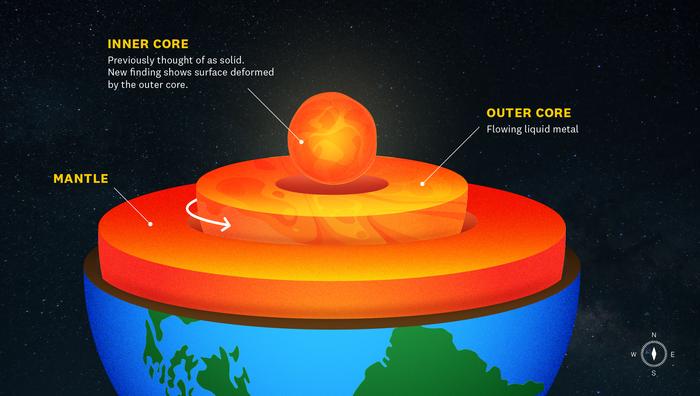Earth’s inner core undergoing structural changes, affecting length of days
Researchers have found evidence of changes in the structure of the Earth’s core.
University of Southern California team, led by Professor John Vidale, was investigating the inner core’s rotation – a topic of ongoing debate. But what they stumbled upon was far more surprising.
The researchers’ initial goal was not to study the inner core’s physical features, but they ultimately found evidence of structural changes at its surface.
Interaction between the inner and outer core is the most likely cause of these structural changes.
“What we ended up discovering is evidence that the near surface of Earth’s inner core undergoes structural change,” Vidale said.
“As I was analyzing multiple decades’ worth of seismograms, one dataset of seismic waves curiously stood out from the rest,” Vidale said. “Later on, I’d realize I was staring at evidence the inner core is not solid.”
The changing surface features of the inner core are likely playing a role in how it spins and how that spin changes over long periods, ultimately affecting the length of our days.

Peculiar seismic waves
Scientists have been debating the nature of the inner core for a long time. However, the primary focus of this debate and most of the research conducted has been on understanding how the inner core rotates within the Earth.
The other potential changes, like structural shifts, have received less attention.
The inner core, situated 3,000 miles beneath the Earth’s surface, is held within the molten outer core. It was previously believed to be a solid sphere.
The study analyzed decades of seismic data, including recordings of repeating earthquakes near Antarctica between 1991 and 2024.
The data was collected from receiver-array stations located near Fairbanks, Alaska, and Yellowknife, Canada.
The team noticed something peculiar — one set of seismic waves, recorded in a Canadian station, stood out. It was unlike anything previously observed by the research team.
Professor Vidale was initially puzzled by the data. These unusual waves hinted at something unexpected happening within the inner core.
Improved analysis revealed that the inner core’s shape appears to be changing over time, suggesting it isn’t entirely solid.
Turbulent molten outer earth core
The study indicates that the surface of the inner core is likely “undergoing viscous deformation” – essentially, it’s changing shape at its boundary.
And the turbulent molten outer core could be behind it.
“The molten outer core is widely known to be turbulent, but its turbulence had not been observed to disrupt its neighbor the inner core on a human timescale,” Vidale said. “What we’re observing in this study for the first time is likely the outer core disturbing the inner core,” the author added in the press release.
This interaction between the inner and outer core is causing the inner core’s surface to shift and deform.
The findings could unravel how the topography of the inner core’s surface might be influencing its rotation.
These rotational changes, in turn, are so subtle that they have actually caused tiny variations in the length of a day on Earth. Furthermore, this finding might be connected to the observed slowing down of the inner core’s rotation over time.
Source: Interesting Engineering
Mysterious Radiation Belts Detected Around Earth After Epic Solar Storm
Earth’s inner core undergoing structural changes, affecting length of days

